PlanetSide 2 Review
Taken as a whole, Planetside 2 is rather spectacular. The most memorable and thrilling moments aren’t the firefights themselves, but those moments when you are walking around, just observing. Watching as fighting occurs as far as the eye can see while the sun sets on one of the most beautiful backdrops in gaming. Only it’s not a backdrop. Everything you see is part of an endless conflict that involves thousands of players. As you stop slogging to ponder this wondrous realization, some dastardly sniper puts an end to your gaping with a well placed bullet to the noggin. The spectacle in Planetside 2 can be so engrossing that you forget what you came in to do: kill, conquer and blow stuff up. That’s because Planetside 2, at its core, is a competitive combined arms massively multiplayer online first person shooter (henceforth a ccammofps) that has more in common with Battlefield than World of Warcraft. When each aspect of the game is scrutinized, a good number of cracks and creaky joints appear, but the scale is so vast and the spectacle so astonishing that these rough edges are ultimately transcended by the tremendous overarching design.
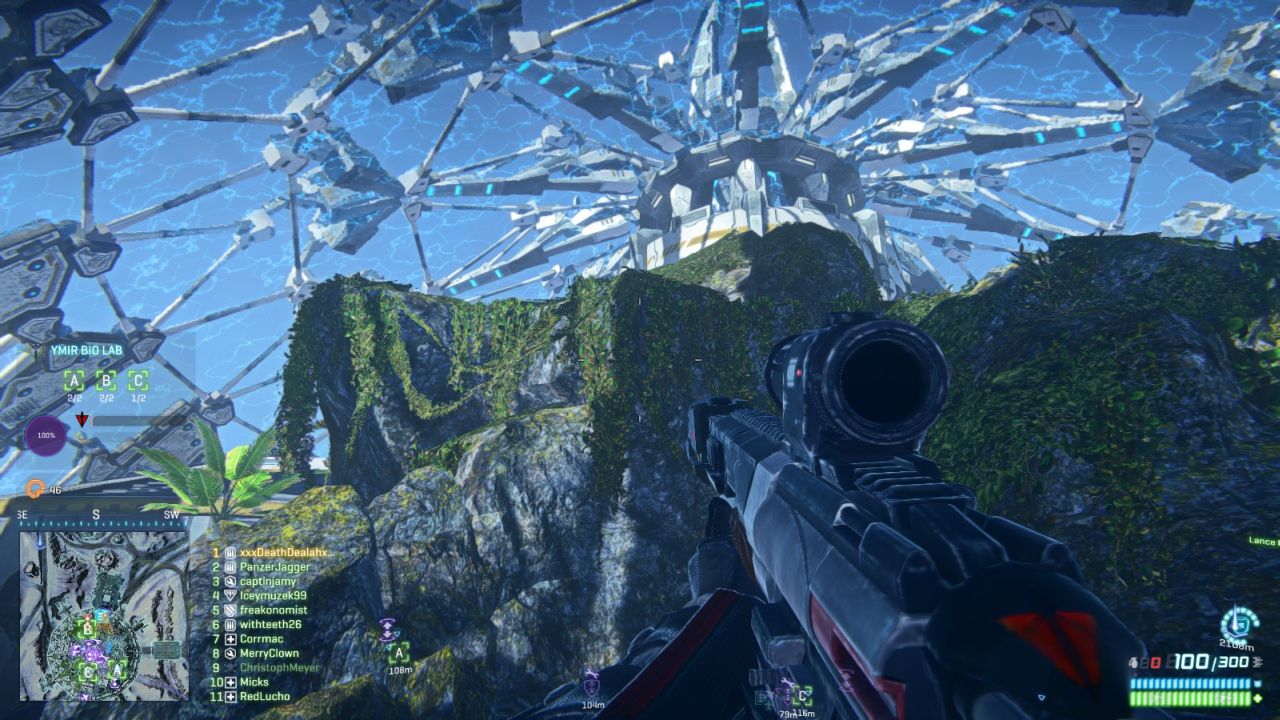
Bio Labs let you warm your fingers after time in the frozen tundra of Esamir
In a nutshell, Planetside 2 revolves around three factions fighting to control three different continents. Each continent, roughly 5x5km in size, is sub-divided into areas controlled by a variety of outposts, mining operations, power-stations and tech-plants. Capturing one of these areas will grant control to one of the factions, and also provide benefits such as the ability to deploy more powerful vehicles or to gain resources at a faster rate. If a faction manages to conquer an entire continent, they are granted a bonus in the way of discounts on purchases of vehicles or infantry upgrades. Each continent can hold up to two thousand players at once, resulting in ongoing and intense conflict along the front lines between factions. When all three factions collide and fight for control of a single area, the action can become incredibly intense and simply surviving can become a challenge.
The broad strokes of Planetside 2’s design seem simple enough, but dig a bit deeper and there is a lot of complexity here that manifests itself in a slew of blinking icons and layers of seemingly encrypted menus. Planetside 2 has no in game tutorial, and will completely baffle new players who jump in without having watched a few tutorial videos in order to become familiar with the basics. Things like character customization and moving between continents are buried in unexpected places, and if you go in without making an effort to learn about the many important details you will likely be overwhelmed by them. Once you figure out how the menus and map works, everything is highly functional and allows for easy access to squads and ways of getting into the action quickly, but the learning curve in Planetside 2 is steep and impenetrable if you don’t find external tutorials.
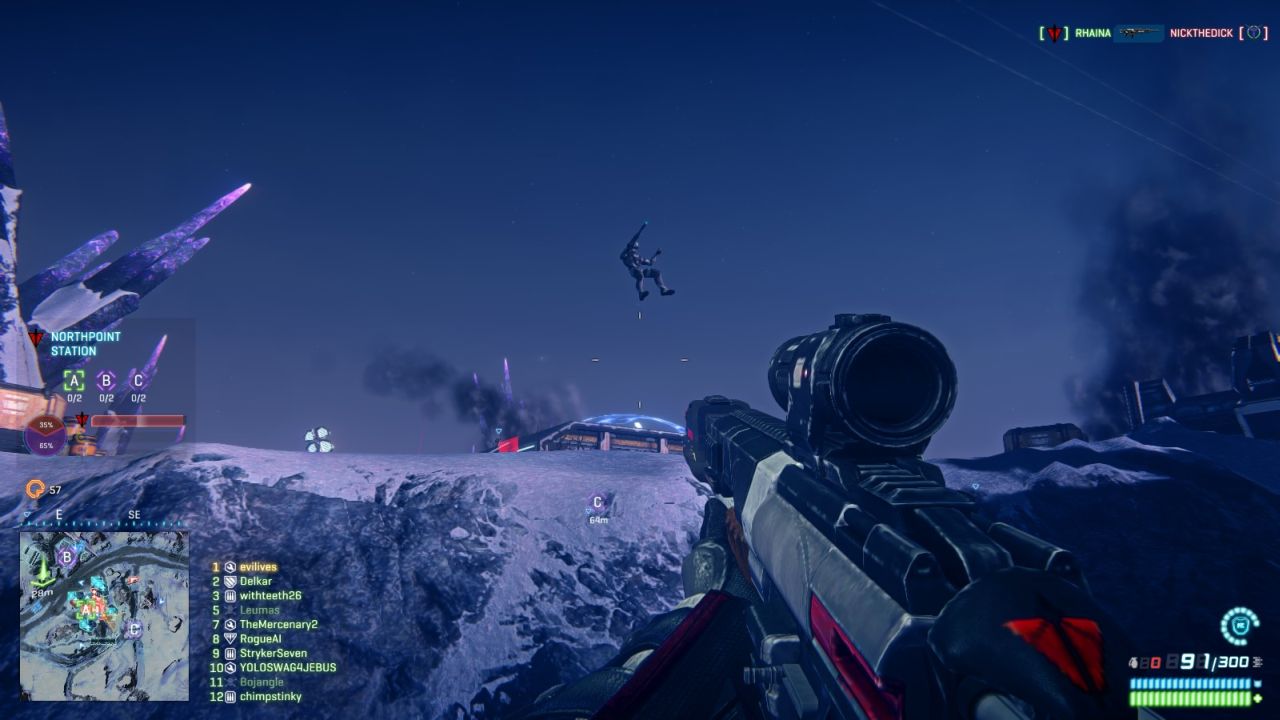
This is either a bug or a very cool unlock
To illustrate some of the complexity I will describe the process involved in capturing a tech plant. The facility has an outer wall, an inner courtyard with a number of small enterable buildings, and a large central building. The outer wall has large openings with shields that allow only those who are part of the faction that control that base to enter. The enemy team must send infantry through side doors and over the walls using jet-packs into the courtyard in order to disable the generators that power the shields for the outer-wall. To do this, the infantry must over-load the generator and then defend it while it overheats and eventually explodes. This disables the shield and allows the vehicles of the attacking faction to enter the inner-courtyard. The large central building also has shields which are multi-layered and powered by multiple generators. These generators must be destroyed using the same process, allowing the attackers access to the central building. This building contains a single battlefield style capture point that the attackers must hold for a fairly long time, after which they will have captured the base. There are also spawn-generators that allow the defenders to spawn, vehicle and infantry terminals which can be hacked or destroyed, turrets on the outer-walls which can be hacked or destroyed, and generators which power the gravity-beams that allows players to rise or fall great vertical distances.
Each different base type has a unique but equally complex capture method, and the complexity makes for rich gameplay that requires some strategy and coordination on the part of squad leaders. Capturing a base results in a juicy experience reward for the attackers, while defenders are given smaller but more regular bonuses for sticking around and killing attackers or repairing generators. While a significant headache for new players, these varied objectives ultimately grant purpose to Planetside 2, which will be appreciated by players who are more used to a shooter where matches have time limits and clear winners and losers. When it comes to playing the game, there are six classes that all play different roles quite similar to those in the old Battlefield games. Light assault troopers have jet packs and assault rifles, heavy-assaulters have anti-vehicle weapons and a temporary shield, infiltrators use sniper rifles and can briefly deploy a stealth cloak, engineers repair vehicles, medics heal and revive while the ‘max suit’ wearer is a heavily armoured beast that can only be healed by engineers.
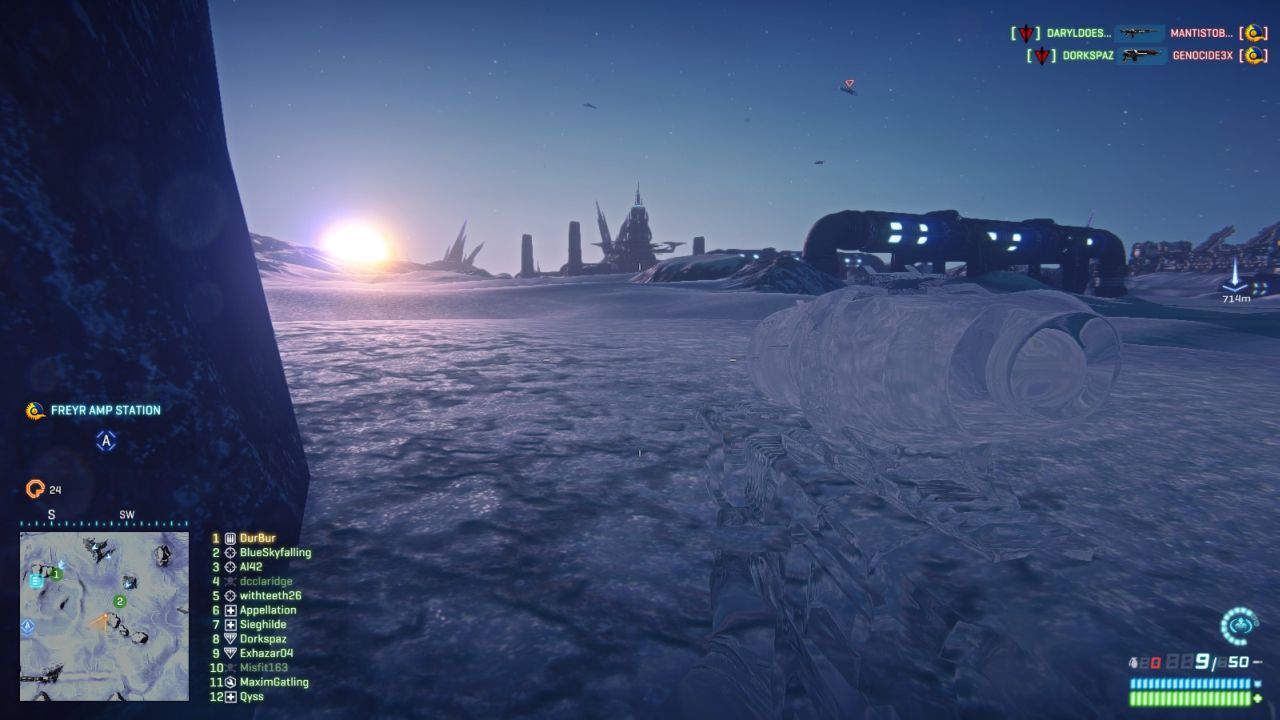
The infiltrator’s cloak makes him ideal for sneaking into enemy bases
As per the standard of today, there is a comprehensive leveling and unlock system that serves as a form of character progression. As a free-to-play game, you can opt to pay money and skip some of the grinding to acquire unlocks, but they are side grades rather than direct upgrades, and this largely prevents imbalance. Everything you can get with real money can also be attained using ‘certification points’ (certs) which you earn by playing, while some upgrades can only be attained using certs. Right now it feels like it takes a bit too long to gain these without paying any money compared to the cost of unlocks, although it is possible to buy a booster that increases the rate at which you gain experience and certs. At this point, it would take a huge amount of time just to unlock everything for a single class without paying money. As far as free-to-play games go, the balance is fairly good, although a new player coming up against a fully-geared player who has invested some money is likely to lose in a head-to-head battle. The massive scale and myriad of targets tends to water down these small imbalances however, and as someone who never paid a dime, I never felt at a disadvantage and even maintained a kill/death ratio much higher than I traditionally do in shooters.
The gunplay itself is also fairly good; weapons have a lot of recoil and bullet physics mean that shooting requires skill at anything more than point blank range. Many of the weapons within the same class of a faction look and feel extremely similar which reduces the incentive to unlock new guns, although the ability to try a weapon before you invest hard-earned certs to unlock it is a welcome one. Finding the right load out for your favourite class is gratifying, but like the best shooters, character customization is secondary to the gameplay. If you tire of hoofing it on the ground, you can spend some of your resources on vehicles or aircraft. Each faction has four different ground vehicles, a dirt-cheap ATV for getting from place to place, a big people-carrier that can be upgraded to serve as a mobile spawn point, and two different types of tanks. There are also a number of different air craft ranging from the fragile but nimble mosquito to the hulking Galaxy that can carry a huge number of people. Each vehicle can be upgraded with various weapons and perks, serving as yet another drain on your certs. Vehicle handling is a bit floaty, especially when trying to drive over the abundant uneven terrain, but once you get used to it the tank battles become thrilling and make for a good change of pace.
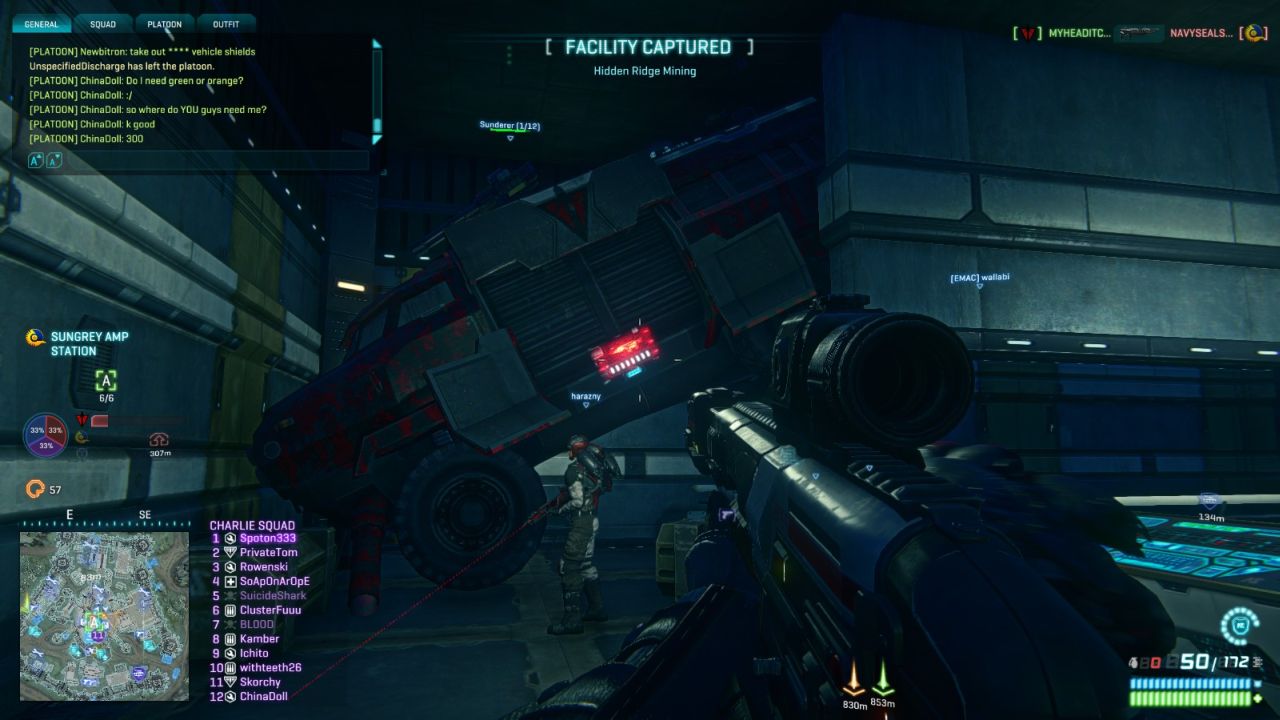
So that’s where I parked my Sunderer
The biggest potential issue with Planetside 2 is that due to its scale you might become stranded and have to hoof it for long periods of time over desolate terrain. This problem is largely avoided thanks to the ability to re-deploy whenever you want and to hot-drop in to battles every twenty minutes or so. Hit insert once when you join a server and you are placed into a squad, hit insert again and you will be spawned near your squad leader. There are still times when you just can’t seem to find the action, or where you get stuck trying to navigate the sometimes glitchy terrain trying to get to a seemingly nearby outpost, but downtime in Planetside 2 is largely kept to a minimum. Playing with a co-ordinated squad that assigns objectives is the best way to have fun, and I have noticed a marked increase in faction-wide teamwork as people figure out how the game works.
Given the scale and ambition of Planetside 2, it isn’t terribly surprising that it looks rather inconsistent from a technical standpoint. Textures on terrain are often muddy, shadows are a bit jagged and character animations are quite stiff. The entire world feels quite static compared to something like Battlefield 3; there are no physics to speak of, when you kill someone they just sort of fall over stiffly, and this reduces the satisfaction of infantry firefights. Some of the technical inconsistency is made up for by superb lighting; if you don’t look too close, Planetside 2 can be absolutely gorgeous as the sun sets on a sky filled with dog fighting aircraft and the northern lights appear on the frozen tundra of Esamir. The day-night cycle gives the environments a dynamic feeling, with night time battles looking particularly impressive. The audio is equally inconsistent; guns sound decent, but explosions sound rather flat and sometimes make no sound at all. Each faction has its own music that swells at key moments of capturing a base, and while serviceable none of it is remarkable or memorable.
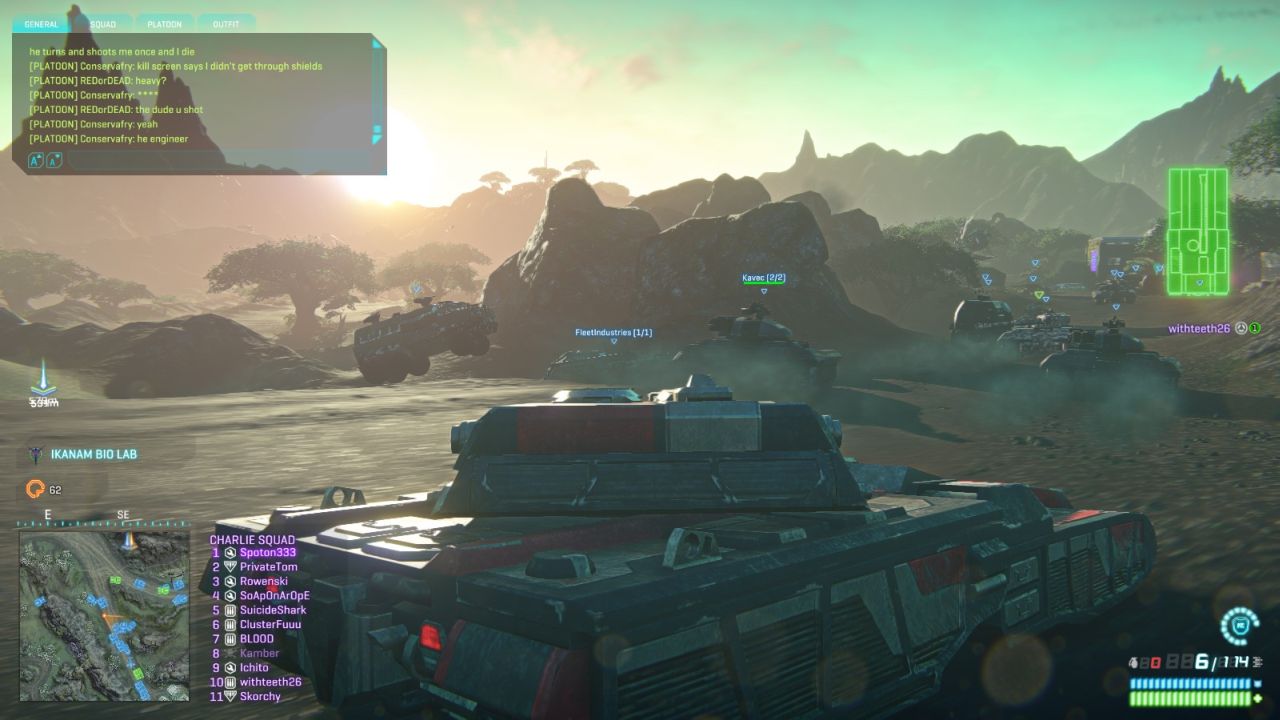
When one tank just won’t get the job done
Another impact of the scope and scale of the game’s combat is that the optimization is rather poor. Even with a powerful modern PC I saw frame rate drops into the 30’s in the largest battles; those with weaker PC’s are likely out of luck if they want to run Planetside 2 at all. On launch there were problems with network lag that caused players to warp around, and while these issues have been greatly reduced, there are still instances of player warping, making them impossible to hit and giving the battles where this occurs a messy feeling. The presence of friendly fire seems like an odd choice given the massive and chaotic nature of some battles, and the warping of players sometimes means you are shooting someone or running them over without realizing it. The developers have been vigilant with updates thus far, and optimization will likely improve in the future, but as it stands, the biggest roadblock that might keep you from playing this game is bad performance.
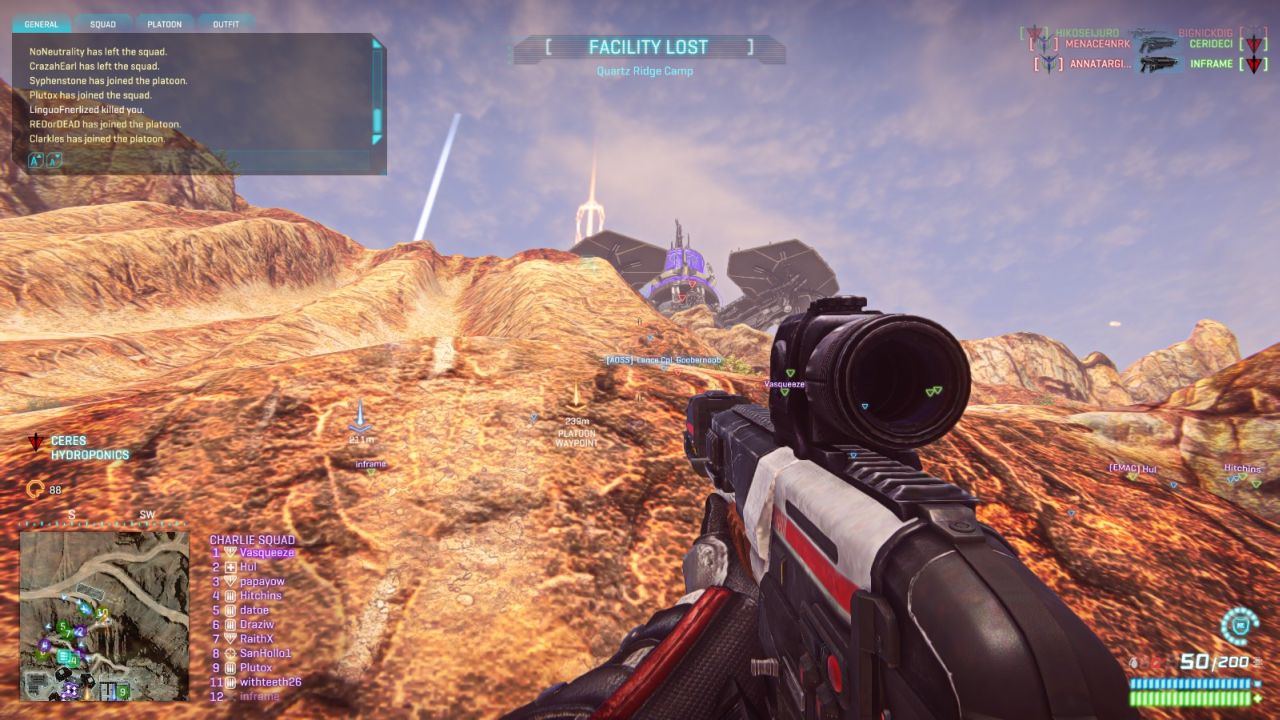
I’ve heard of uphill battles but this is ridiculous
It is difficult to do justice to Planetside 2’s more extraordinary moments through writing; such is the importance of spectacle in making the game stand out. The feeling of being part of something far greater than yourself or even your squad gives the game a unique feel in a crowded genre, and the times when you are rolling with a huge group of tanks or defending an outpost against impossible odds are made significantly more compelling when placed in the context of a greater conflict. While Planetside 2’s free to play nature invites quick judgement and likely sour first impressions, it can’t really be judged quickly, so if it sounds interesting, have the patience to learn the basics before jumping in. The initially overwhelming number of mechanics and options will later give way to a rich and rewarding experience unlike any other.
